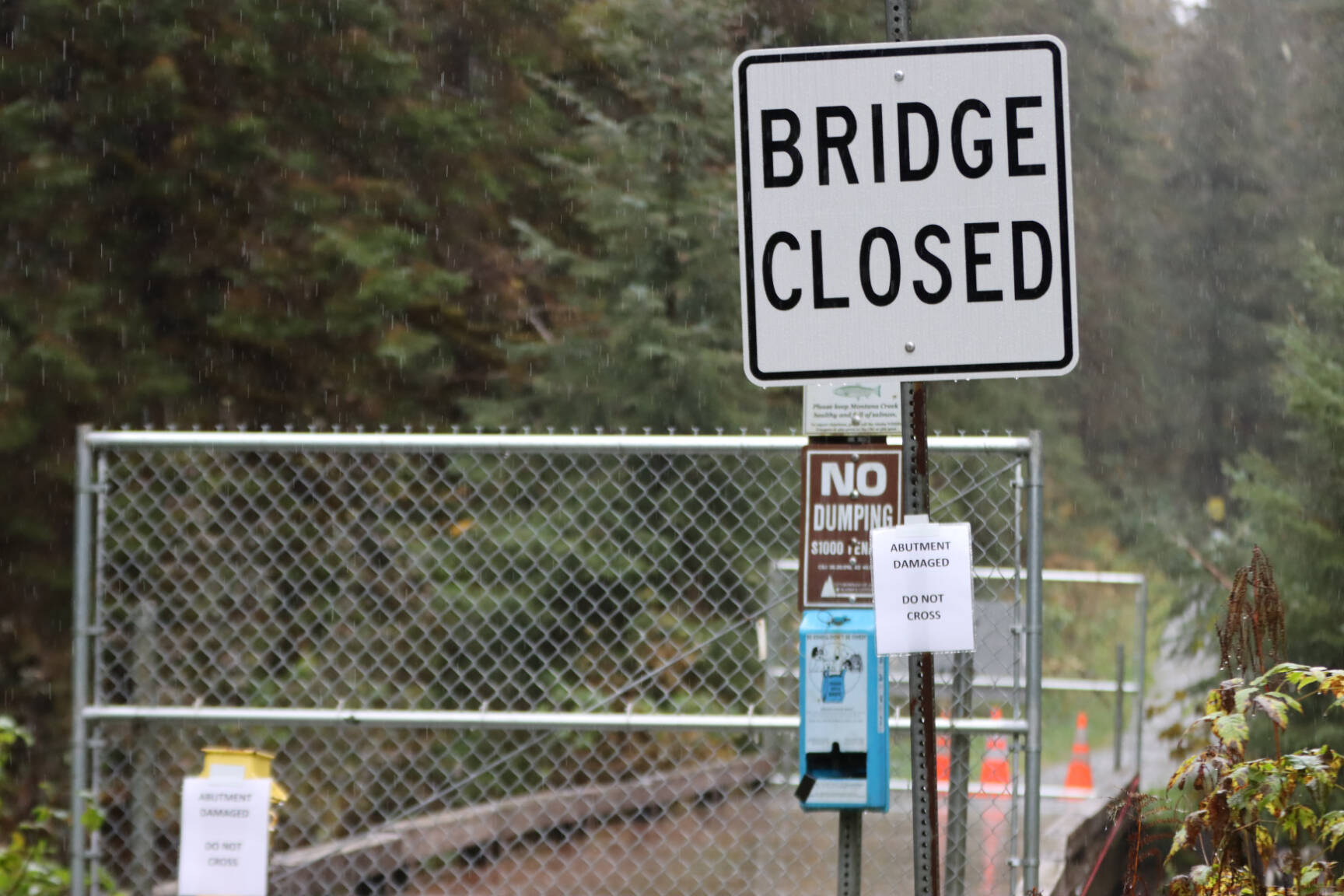When it rains in Juneau, it pours, and all throughout the month of September that was proven with heavy rainfall that not only broke records but also broke bridges.
The Montana Creek pedestrian bridge located beyond the Hank Harmon Public Shooting Range was closed by the Alaska Department of Transportation and Public Facilities after an inspection on Friday, Sept. 30 determined that substructure damage was sustained during recent weather events. Department spokesperson Sam Dapcevich said the bridge will remain closed until crews can fully assess whether repairs can realistically be made.
“The portion of the Montana Creek bridge that Alaska DOT&PF owns and is responsible for is closed because of a washout on one end of it and damage from debris hitting it over time,” Dapcevich said. “It’s going to be closed until we can identify either some repair work that can be done, our bridge engineer team is going to evaluate that, or they may decide that it needs to be replaced, it’s not in very good shape.”
Additionally, the portion of the Montana Creek pedestrian bridge on the Kaxdigoowu Héen Dei, also known as the Brotherhood Bridge Trail, was closed on Wednesday, Sept. 28 by the City and Borough of Juneau due to risk of structural failure after an inspection revealed damage to the bridge abutment from recent heavy rains.
According to a social media post issued by CBJ, a barrier has been installed to limit bridge access and everyone is asked to obey posted warning signs and avoid attempting to access the bridge. The closure includes foot traffic and will remain closed until the damage is assessed and repairs are complete.
On Monday, Sept. 26, a landslide followed a period of heavy rain. It badly damaged multiple homes and a vehicle causing people to be temporarily displaced and Gastineau Avenue to be closed for a few days.
“The debris pile would fill about half of a football field and yet the slide itself started hundreds of feet up the mountain, you can’t even see it when you look up to the ridge on the mountain, so it came down a long ways and brought a lot of material, and now that material is quite deep,” CBJ emergency program manager Tom Mattice previously told the Empire.
How does it measure up?
Kimberly Vaughan, observation program leader with the National Weather Station in Juneau, said that the month of September saw numerous days receive more than an inch of rain, with Tuesday, Sept. 27, breaking a rainfall record over 85 years old.
“The heaviest rainfall we got in one day was on Sept. 27 with 2.22 inches. For precipitation the Juneau Airport recorded 2.22 inches which broke the previous record of 2.02 inches that was set back in 1936,” Vaughan said. “In the last week (last 7 days) 5.72 inches that includes three days of an inch or more of precipitation on Sept. 23, 26, and 29, they all had over an inch of rainfall.”
According to Vaughan the Juneau Airport received 9.85 inches of rain in September and so far this year Juneau has seen 63.68 inches of precipitation, which broke the previous record of 63.31 inches set back in 2015. Vaughan added that along with precipitation records being broken throughout September, so were high temperatures.
“Sept. 26 was a very noteworthy day with high temperatures also being broken along with precipitation records being broken,” Vaughan said. “The Juneau Airport tied its 1981 record at 60 degrees all the way back in 1981. Several other stations around Southeast and the Juneau area like Auke Bay also got 60 degrees, Eaglecrest saw 58 degrees, and the Juneau Forecast Office saw 64 degrees.”
Looking ahead into October, Vaughan said we should expect to receive even more precipitation than the previous month, as October is typically a wetter month for Juneau. Vaughan added that additional storm systems moving in through the region isn’t abnormal, but seeing higher precipitation numbers is what starts to become alarming.
“We’re a rainforest, so we’re used to getting a lot of rain, it’s just when we get a lot of rain in a shorter amount of time that then really the impacts start to build up,” Vaughan said. “It’s the kind of situation where some rain where steep terrain have good drainages to our rivers and streams, everything can kind of handle that, an inch or less is no big deal but now we’re sitting here looking at one to three in a 24-hour period, that then becomes impactful and starts making the rivers rise and ditches fill and all of those things.”
• Contact reporter Jonson Kuhn at jonson.kuhn@juneauempire.com.

